Employee performance reviews are more than just a routine HR exercise – they’re a powerful tool to tap into the full potential of your workforce and drive organizational success. Whether you’re an experienced manager or stepping into a leadership role for the first time, mastering the art of performance reviews can significantly enhance your team’s productivity, engagement, and overall growth.
In this blog post, we’ll guide you through everything you need to know about employee performance reviews—from A to Z. You’ll discover how to conduct impactful reviews that inspire and motivate your team, and learn how performance management software can streamline the process, making it more efficient and effective.
Key Takeaways
Effective employee performance reviews are essential for organizational success and employee development. They offer a structured framework to evaluate, recognize, and develop your workforce, boosting productivity and engagement.
Various types of performance reviews exist, such as individual vs 360-degree, annual vs quarterly vs continuous, and goal-oriented vs project-based vs probationary.
Preparing for and conducting effective employee performance reviews involves several best practices, such as:
👉 Setting clear objectives and expectations
👉 Gathering relevant data and feedback
👉 Creating clear and ambitious goals aligned with organizational objectives
👉 Providing constructive, specific and timely feedback
👉 Utilizing performance metrics to measure progress objectively

What is an Employee Performance Review?
An еmployее performance rеviеw is a systematic process that еvaluatеs an individual’s work-rеlatеd accomplishmеnts and bеhaviors. It goes beyond thе supеrficial assеssmеnt, aiming to providе constructivе fееdback, rеcognizе achiеvеmеnts, and еstablish a roadmap for continuous improvеmеnt.
What are the Different Types of Employee Performance Reviews?
Employee performance reviews come in diverse forms based on the number of voices, the cadence of assessments, and the specific focus of the evaluation.
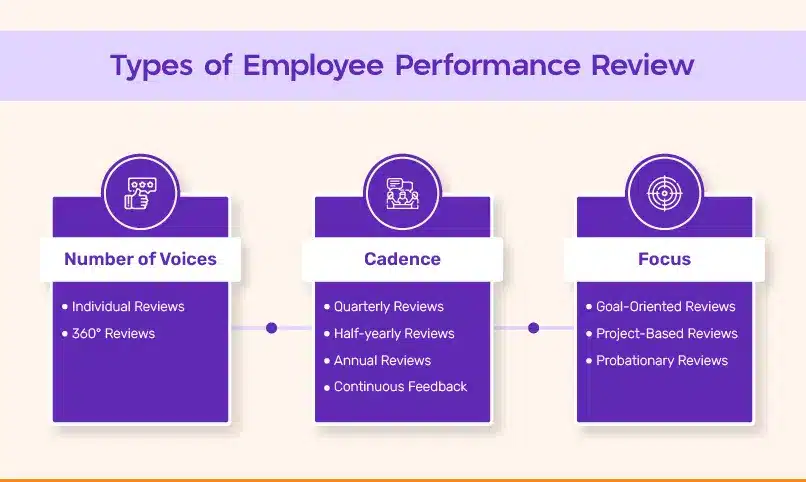
Types of Employee Performance Reviews Based on the Number of Voices
👨💼 Individual Reviews: This is the traditional one-on-one evaluation between an employee and their supervisor, providing a personalized assessment of performance.
🔄 360-Degree Reviews: This comprehensive approach gathers feedback from multiple sources, including peers, supervisors, subordinates, and the employees themselves, offering a well-rounded view of an employee’s performance.

Types of Employee Performance Reviews Based on the Cadence
🗓️ Annual Reviews: Conducted once a year, these reviews provide an in-depth analysis of performance over the previous 12 months, capturing long-term trends.
📅 Quarterly and Half-Yearly Reviews: These assessments occur more frequently than annual performance reviews, allowing for timely feedback and adjustments to performance.
💬 Continuous Feedback: This approach involves ongoing evaluations and performance discussions on a weekly or fortnightly basis, fostering a culture of regular feedback and immediate improvements.
Types of Employee Performance Reviews Based on Focus
🎯 Goal-Oriented Reviews: These reviews assess an employee’s performance based on specific career goals and objectives, linking individual efforts to organizational targets.
With performance review software like Peoplebox, you can set goals in seconds.
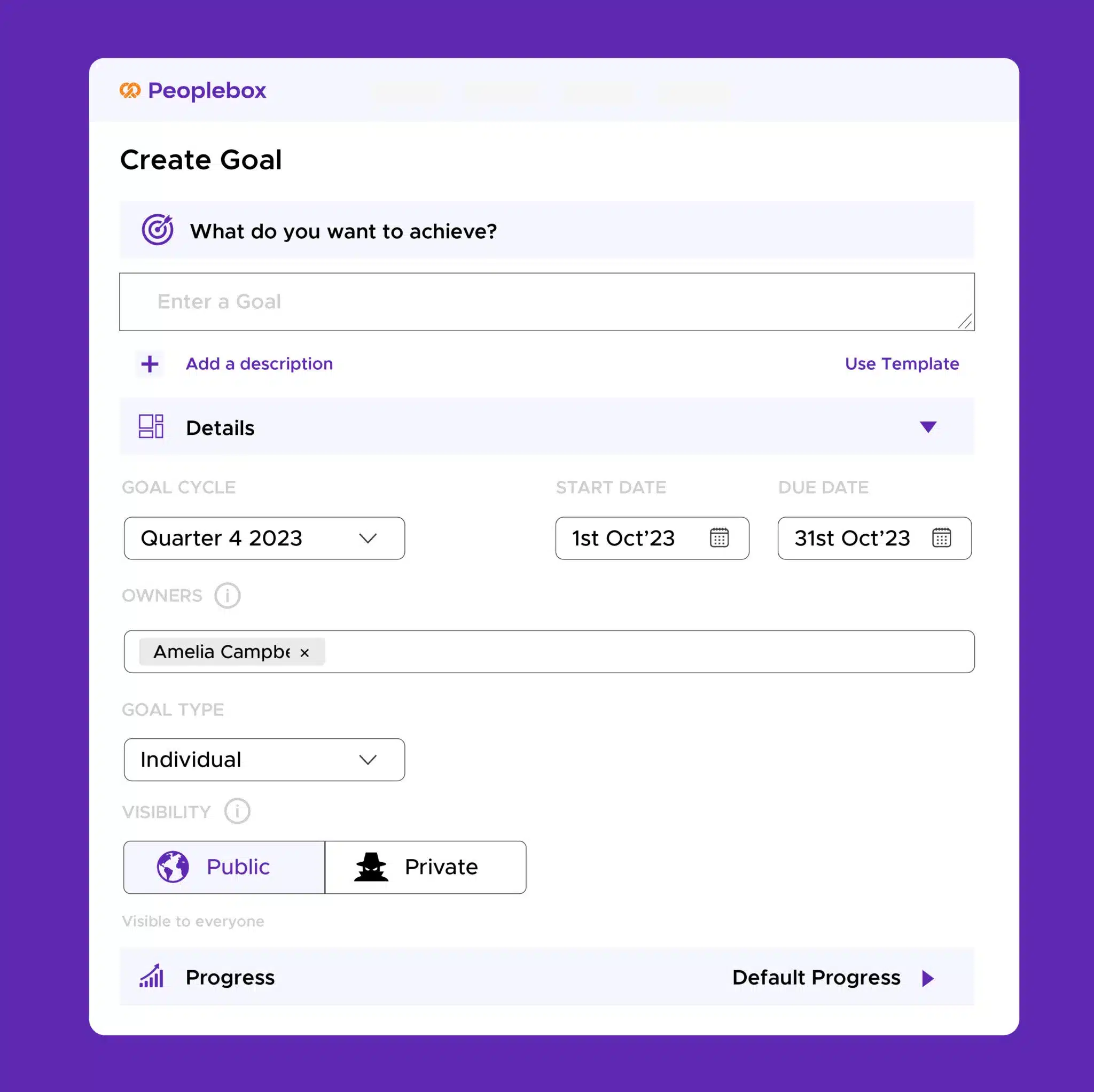
🧾 Project-Based Reviews: Focused on contributions to specific projects, these evaluations provide insights into performance within particular contexts.
⏲️ Probationary Reviews: Conducted during an employee’s probationary period, these reviews help determine suitability for continued employment and set early performance expectations.
Understanding the different types of performance reviews empowers organizations to tailor their approach, ensuring that the evaluation process aligns seamlessly with their goals and the unique dynamics of their workforce.
Who Conducts Employee Performance Review?
Employee performance reviews are typically conducted by a combination of key organizational stakeholders. The individuals involved in conducting performance reviews play distinct roles, each contributing to a comprehensive assessment of an employee’s contributions and development.
Here are the primary parties who commonly conduct employee performance reviews:
👉 Supervisors and Managers: They serve as the main evaluators, possessing direct knowledge of the employee’s daily performance.
👉 HR Professionals: These individuals facilitate the review process, ensuring it is well-structured and fair.
👉 Peers: They participate in a 360-degree feedback system, providing valuable insights into collaboration and teamwork.
👉 Subordinates: Occasionally, they offer upward evaluations, presenting distinct perspectives on leadership effectiveness.
👉 Employees Themselves: They engage in self-assessments, reflecting on their achievements and setting future goals.
👉 Executive Leadership: They establish the overall performance expectations, ensuring alignment with the organization’s objectives.
👉 External Consultants (Occasionally): They may provide an impartial viewpoint, particularly for senior-level evaluations.
Peoplebox lets you choose from the 4 primary reviewer roles and easily add customized additional roles for your organization.

What to Assess in Employee Performance Evaluation?
To ensure a comprehensive understanding of an individual’s contributions, various dimensions must be assessed. From job-specific competencies to interpersonal skills and alignment with organizational goals, the evaluation process encompasses various factors.
Here’s a quick look at the various employee evaluation factors:
| Performance Dimension | Description |
| 1. Job-Specific Competencies | Assess the employee’s proficiency in job-related skills and tasks. Evaluate technical knowledge, problem-solving abilities, and adherence to industry best practices. |
| 2. Communication Skills | Evaluate written and verbal communication skills, including conveying ideas clearly, actively listening, and collaborating effectively with team members. |
| 3. Teamwork and Collaboration | Examine the employee’s ability to work collaboratively, contribute to group goals, and foster a positive team environment. |
| 4. Goal Achievement | Assess how the employee meets and exceeds established goals and targets, demonstrating a commitment to achieving individual and organizational objectives. |
| 5. Adaptability and Flexibility | Evaluate how well the employee adapts to changing circumstances, handles ambiguity, and demonstrates flexibility in adjusting to evolving work requirements. |
| 6. Leadership and Initiative | For those in leadership roles, assess leadership qualities, decision-making skills, and the ability to take initiative in driving projects and improvements. |
| 7. Problem-solving and Critical Thinking | Examine the employee’s capacity to analyze problems, propose effective solutions, and demonstrate critical thinking in addressing challenges. |
| 8. Interpersonal Skills | Evaluate how well the employee interacts with colleagues, clients, and stakeholders, considering factors such as empathy, conflict resolution, and relationship-building. |
| 9. Time Management and Productivity | Assess the employee’s ability to manage time efficiently, prioritize tasks, and maintain high productivity. |
| 10. Professional Development | Consider the employee’s commitment to continuous learning and professional growth, including participation in training, acquiring new skills, and staying updated on industry trends. |
With tons of competencies one can look into, identifying the ones that work in your organization can be tricky. That’s why, we’ve compiled a list of performance review competencies examples to excel in 2024.
What are the Benefits of Employee Performance Reviews?
Employee performance reviews are a valuable tool for both employees and organizations. When conducted effectively, they can yield numerous benefits.
Benefits of Employee Performance Reviews for Employees
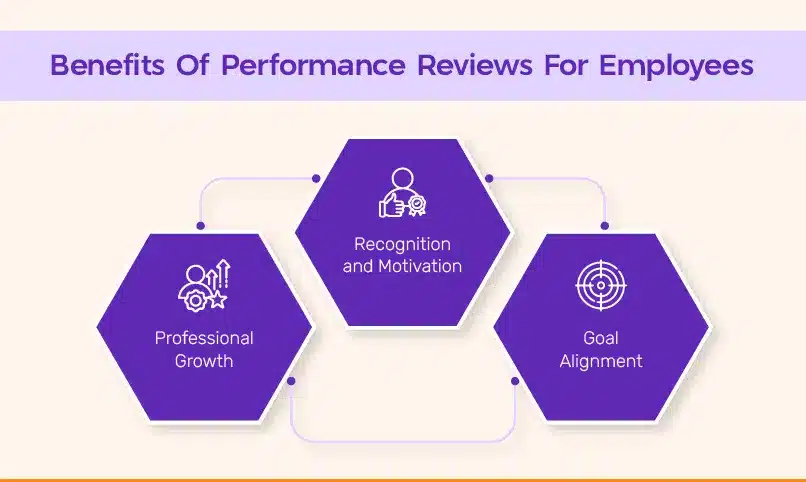
📈 Professional Growth
Performance reviews provide a structured platform for employees to receive helpful feedback, identify strengths, and pinpoint areas of improvement. This facilitates targeted professional development and enhances the employee’s career growth opportunities.
💪 Recognition and Motivation
Positive feedback during performance reviews acknowledges employees’ hard work and achievements. This recognition is a motivational factor, boosting morale and reinforcing a sense of value within the organization.
🎯 Goal Alignment
Performance reviews align individual goals with organizational objectives. This clarity ensures that employees understand their roles in contributing to the company’s success, fostering a sense of purpose and direction.
Benefits of Employee Performance Reviews for Organizations
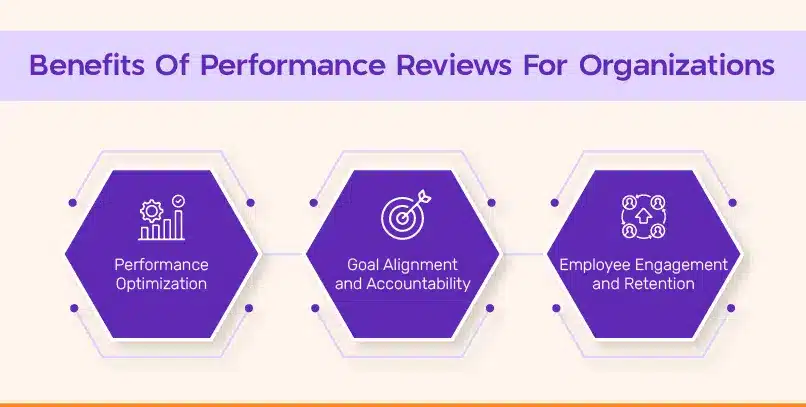
⚙️ Performance Optimization
Regular evaluations enable organizations to identify high performers and areas for improvement. This insight allows for strategic talent management, optimizing workforce performance, and addressing skill gaps.
🎯 Goal Alignment and Accountability
Performance reviews ensure employees’ efforts align with organizational goals. Organizations can enhance overall productivity and efficiency by establishing clear expectations and holding individuals accountable.
🧑🤝🧑 Employee Engagement and Retention
Constructive employee feedback and recognition foster a positive work environment, increasing employee satisfaction and engagement. This, in turn, contributes to higher retention rates, reducing recruitment costs and maintaining institutional knowledge.
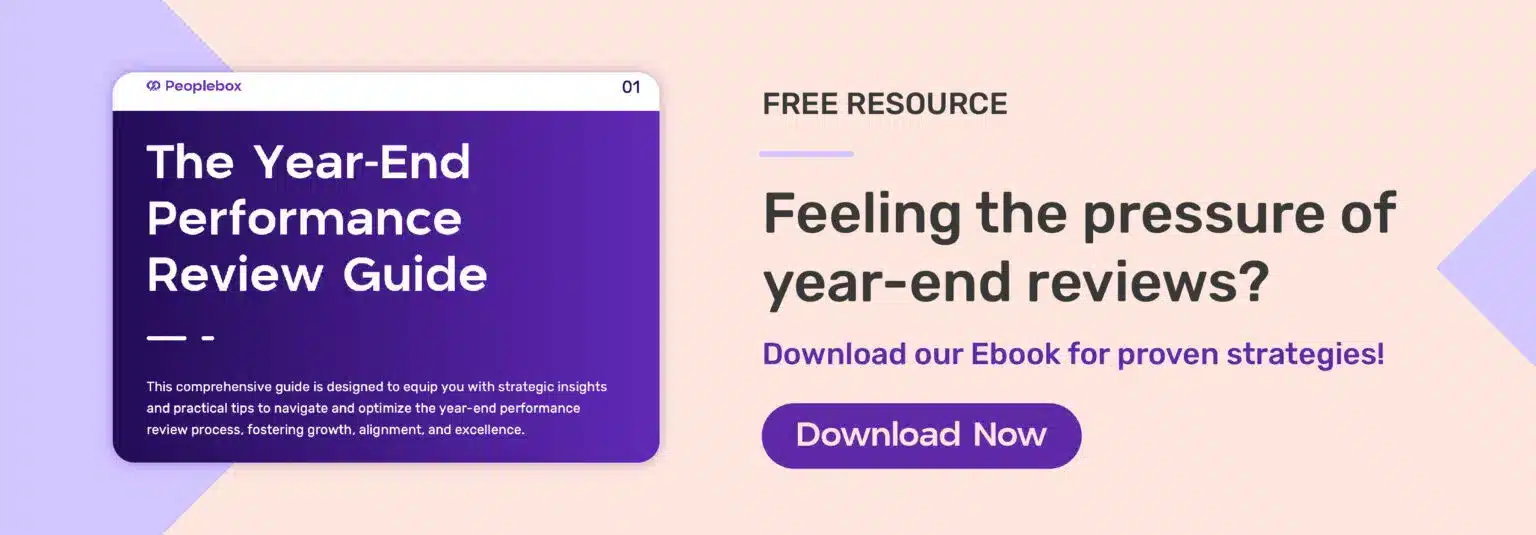
How to Prepare for Employee Performance Reviews?
Now that we’ve established the significance of employee performance reviews, let’s look at how you can prepare for an effective review.
Step 1: Setting the Stage for Success
Creating an environment that fosters growth and open communication is not just a prelude to a performance review but an ongoing commitment to organizational excellence.
1.1: Schedule in Advance
Extend the courtesy of time to your employees by scheduling performance reviews well in advance. This demonstrates respect for their schedules and allows for meaningful reflection.
With performance review software like Peoplebox, you can schedule regular one-on-ones with ease. Try it yourself!
1.2: Use Positive Language
Language shapes perception. Frame feedback positively, emphasizing achievements and growth opportunities rather than dwelling solely on challenges.
We talk all about how you can share constructive feedback effectively in our blog post, 45 negative feedback examples that are not offensive.
1.3: Active Listening
Make the performance review a two-way street. Actively listen to employees, acknowledging their insights and concerns, fostering a collaborative atmosphere.
1.4: Clearly Define Objectives
Articulate the purpose and objectives of the performance review clearly. This not only aligns expectations but also underscores the strategic importance of the process.
1.5: Share Evaluation Criteria
Transparency is key. Provide a detailed outline of the criteria against which employees will be evaluated. This transparency empowers employees to align their efforts with organizational goals.
Step 2: Gathering Relevant Data
The data collected before a performance review is not merely a set of numbers; it’s a narrative of an employee’s journey within the organization. Understanding the story behind the performance data is crucial for meaningful conversations.
With Peoplebox, managers can easily provide goal-focused feedback, ensuring data-driven evaluations and avoiding arbitrary assessments.
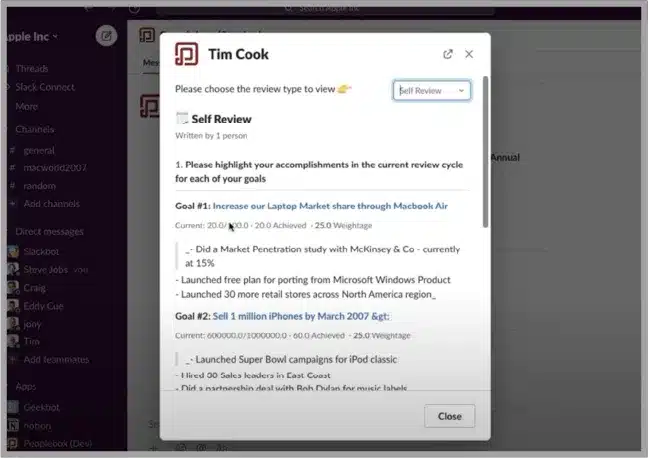
Why does Collecting Data Matter?
✔️ Objective Assessment: Data provides the cornerstone for an objective evaluation, minimizing biases and ensuring fairness.
✔️ Identifying Patterns: Beyond numbers, data reveals performance patterns over time, offering a nuanced understanding of an employee’s journey.
✔️ Documenting Achievements: Data serves as a documented testament to an employee’s achievements, offering tangible evidence of their impact on the organization.
Here’s a list of data to gather for employee performance evaluations:
| Checklist Item | Description |
| Performance Metrics | Analyze KPIs and job-related metrics during quarterly and half-yearly reviews for a focused understanding of employee contributions and areas to improve. |
| Feedback from Colleagues | Gather insights from colleagues during periodic assessments, fostering teamwork and providing a holistic view of collaborative skills. |
| Self-Assessment | Encourage active participation through regular self-assessments during quarterly and half-yearly reviews, promoting accountability and continuous improvement. |
| Project Highlights | Document key projects, contributions, and challenges faced to offer a comprehensive overview of an employee’s journey, enhancing motivation and purpose. |
| Training and Development Records | Recognize growth efforts by highlighting training sessions, certifications, and professional development activities during quarterly and half-yearly reviews, emphasizing their importance for individual and organizational success. |
By infusing intention and thoughtfulness into the preparation for performance reviews, organizations not only navigate the evaluation process but also cultivate an environment where every review becomes a transformative moment in the professional journey of employees.
If you’re a manager looking to dive deeper into the best practices for preparing for performance reviews, don’t miss our blog post.
What Should be Included in Employee Performance Review?
An employee performance review should include a comprehensive evaluation of the employee’s job performance, covering key areas such as achievements, strengths, areas for improvement, and progress toward previously set goals.
It should also incorporate specific examples to illustrate performance levels, feedback from peers or supervisors, and any relevant metrics or KPIs. Additionally, the review should outline future goals and development opportunities, fostering a constructive dialogue between the manager and the employee.
How to Conduct Employee Performance Review
1. Set Clear and Ambitious Goals
Goal setting is a cornerstone of effective performance management, pivotal in driving employee engagement, productivity, and overall organizational success.
Clear and ambitious goals provide a roadmap for employees, outlining expectations and fostering a sense of purpose within the workplace.
The performance review process is not just an annual formality; it’s a strategic opportunity to align individual objectives with broader organizational goals. By emphasizing the importance of goal setting, organizations can ensure that employees understand their role in contributing to the company’s success.
Tip: You can use strategy execution platforms like Peoplebox to align individual objectives with organizational goals.

Objectives and Key Results (OKRs) are a powerful tool for goal setting, allowing organizations to define ambitious yet achievable targets.
When implementing OKRs in the performance review process, it’s crucial to align individual goals with the organization’s broader objectives.
1. Clarity is Key: Clearly articulate objectives to avoid ambiguity. Employees should have a precise understanding of what is expected of them.
2. Strategic Alignment: Ensure that individual goals contribute to achieving larger organizational objectives. This alignment fosters a sense of purpose and collective achievement.
3. Regular Check-ins: Establish a system of regular weekly check-ins to monitor progress and make necessary adjustments. This promotes continuous improvement and keeps goals relevant.
If you’re just diving into OKRs and feeling a bit overwhelmed, we get it! To make things easy, check out our guide, ‘The Ultimate OKR Cheat Sheet.’ It’s got all the what, why, and how covered. Give it a look!

2. What to Say in an Employee Performance Review?
Effective performance reviews involve more than just assessing achievements; they also require providing constructive feedback. The way feedback is delivered significantly impacts an employee’s motivation and career development. Here are strategies to ensure constructive feedback:
⏲️ Be Specific and Timely
Provide specific, timely, and relevant feedback on the employee’s work performance. This allows for a clear understanding of expectations and areas for improvement.
🥪 The Sandwich Method
Balance constructive criticism with positive feedback. Start and end with positive remarks, sandwiching areas for improvement in between to soften the impact.
↔️ Encourage Two-way Communication
Foster an open dialogue during performance reviews. Encourage employees to share their perspectives and concerns, creating a collaborative environment.
Still wondering what to say? We know, performance reviews can be tricky, especially when you’re not sure what to say. That’s why, we curated a list of 45+ employee review examples that you can use this review season.
3. Performance Review Phrases to Avoid: What Not to Say
During performance reviews, the choice of language is crucial for fostering a positive and constructive environment.
Certain phrases, if used thoughtlessly, can hinder effective communication and demotivate employees. Steering clear of these phrases enhances the overall impact of the review process:
1. “You always/never…”
Avoid: “You always miss deadlines.”
Instead: “Occasionally, there have been challenges in meeting deadlines. Let’s discuss strategies for improvement.”
2. “This is how we’ve always done it.”
Avoid: “This is how we’ve always done things; no need for change.”
Instead: “Let’s explore innovative approaches that could enhance our processes. Your input is valuable.”
3. “You should know this already.”
Avoid: “You should know how to handle this; it’s basic.”
Instead: “Let’s review this together to ensure clarity. If there are any gaps, we can address them through additional training.”
4. “It’s not my job to teach you that.”
Avoid: “It’s not my job to teach you these basic skills.”
Instead: “I’m here to support your learning. If you’re unsure about something, let’s discuss how we can get you the resources you need.”

4. Utilizing Performance Metrics
Performance metrics add a quantitative dimension to the performance management process, offering objective insights into an employee’s contributions.
By utilizing metrics, organizations can measure progress, identify areas for improvement, and make informed decisions about promotions, training, or development opportunities.
1. Key Performance Indicators (KPIs)
Identify and measure KPIs relevant to each role. For sales, this might include conversion rates, while for customer service, it could be response time or customer experience. Interpretation involves comparing actual performance against established benchmarks.
Some metrics you can track include:
| Role | Key Performance Indicator (KPI) | Description |
| Sales | Conversion Rate | Percentage of leads that convert into paying customers. |
| Average Deal Size | Average revenue generated per closed deal. | |
| Sales Growth Rate | Percentage increase in sales over a specific period. | |
| Customer Service | First Call Resolution Rate | Percentage of customer inquiries resolved on the first call. |
| Average Response Time | Average time taken to respond to customer inquiries. | |
| Customer Satisfaction Score (CSAT) | Measure of customer satisfaction based on pulse surveys. | |
| Marketing | Website Traffic | Total number of visitors to the website over a specific period. |
| Lead Generation Rate | Number of new leads generated through marketing efforts. | |
| Return on Marketing Investment (ROMI) | Revenue generated for every dollar spent on marketing. | |
| Manufacturing | Production Efficiency | Ratio of actual output to potential output in a given time. |
| Defect Rate | Percentage of products that fail quality standards. | |
| Average Manufacturing Cycle Time | Average time taken to produce a product from start to finish. | |
| Human Resources | Employee Turnover Rate | Percentage of employees who leave the organization over a specific period. |
| Employee Satisfaction Index | Measure of employee satisfaction based on surveys. | |
| Time to Fill Positions | Average time taken to fill open job positions. | |
| Finance | Net Profit Margin | Percentage of revenue remaining after all expenses are deducted. |
| Current Ratio | Measure of a company’s ability to pay short-term obligations. | |
| Days Sales Outstanding (DSO) | Average number of days it takes to collect payment after a sale. |
2. Quality and Accuracy Metrics
For roles where accuracy is crucial, track error rates and quality metrics. Interpretation involves understanding the root causes of errors and implementing corrective actions.
3. Project Timelines and Milestones
Evaluate team members involved in project management by examining their ability to meet deadlines and achieve project milestones. Interpretation involves assessing time management skills and identifying areas for improvement.
Now that we have covered how you can conduct effective performance reviews, let’s discuss the challenges you might face.
Employee Performance Reviews Challanges to Overcome
While employee performance reviews are a great way to grow your organization, they are not without their challenges.
Identifying and addressing these challenges is crucial for ensuring that employee reviews are fair, constructive, and contribute positively to both individual and organizational growth.

1. Subjectivity and Bias
Performance reviews are susceptible to subjectivity and bias, which can undermine the fairness of the evaluation process. Managers may unconsciously favor certain employees or rely on personal opinions rather than objective criteria.
How to Mitigate Subjectivity and Bias
👉 Implement standardized evaluation criteria.
👉 Train managers to focus on measurable performance metrics.
👉 Incorporate multiple perspectives, including subordinate and peer feedback, for a holistic view.
2. Inadequate Feedback
Providing constructive and specific feedback is essential for employee development. However, inadequate feedback, such as vague comments or a lack of actionable insights, can hinder the improvement of employees.
How to Improve Feedback Quality
👉 Emphasize detailed and constructive feedback in manager training.
👉 Foster a culture of continuous feedback, beyond formal review periods.
👉 Equip managers with skills to communicate both strengths and areas for improvement effectively.
3. Frequency and Timing
Irregular or infrequent performance reviews can diminish their effectiveness. A lack of consistent feedback may result in missed opportunities for employee growth and improvement.
How to Ensure Consistent Reviews
👉 Establish a regular schedule for the performance review meeting, such as quarterly, semi-annually, or annually.
👉 Communicate the purpose and timing of reviews consistently to help employees prepare and engage meaningfully.
With performance review platforms like Peoplebox, you can easily schedule 1-on-1s and periodic check-ins to ensure your entire team performance is on track. The best part? You get all insights from each check-in in one place!

4. Goal Misalignment
When employees’ individual goals are not aligned with organizational objectives, it can lead to confusion and a lack of motivation.
How to Align Goals Effectively
👉 Establish clear and transparent goal-setting processes.
👉 Regularly communicate organizational objectives to employees.
👉 Ensure individual goals align with broader organizational goals.

5. Lack of Employee Involvement
An effective performance review should not be a one-sided conversation dominated by managers. Lack of employee involvement can result in disengagement and dissatisfaction.
How to Foster Employee Involvement
👉 Encourage employee self-assessment and reflection.
👉 Actively seek input from employees about their achievements, challenges, and career aspirations.
👉 Foster a collaborative approach to create a sense of ownership and ensure employees feel heard and valued.
6. Fear of Negative Consequences
Employees may fear that honest self-assessment or admitting to challenges could have negative repercussions, hindering open communication.
How to Avoid Fear of Negative Consequences
👉 Emphasize the developmental nature of performance reviews rather than a punitive approach.
👉 Focus on coaching and supporting employees instead of solely highlighting areas for improvement.
👉 Create an environment where employees feel comfortable discussing challenges and seeking guidance without fear of reprisal.
🥨 Conduct Best Employee Performance Reviews with Peoplebox
Peoplebox serves as a holistic employee evaluation solution, addressing the intricacies of performance management with finesse. Its integration capabilities with existing tools such as Slack, Teams, Jira, Asana, GoogleSheets, and more signify a commitment to providing real-time updates and fostering continuous engagement.
From OKR tracking to performance reviews, Peoplebox stands as a comprehensive platform that covers every facet of employee management.
Ready to experience the transformation? Connect with us today and discover how Peoplebox can empower your organization by simplifying processes, fostering engagement, and strategically managing performance.








